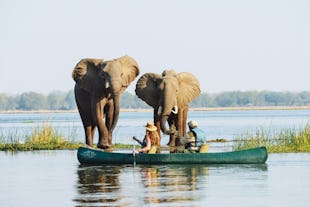
7 active safari ideas
Keep your heart rate high



Just to the north of Moremi, in a palm-filled corner of the north-eastern Delta, lies the Khwai Private Reserve. On the ground, the elite (and excellent) selection safari lodges work in partnership with the local Khwai community and the Khwai Development Trust, and all three promote conservation and eco-tourism. Landscape-wise, swathes of mopane trees characterise the north whilst the south morphs into an iconic Delta scene of open grasslands, waterholes, shiny floodplains and winding waterways that weave across the greenery. Whilst the channels and lagoons are usually full enough for a mokoro safari in the peak season (June to October), it’s the Khwai River – and accompanying game drives – that really steal the show. The lifeblood of the reserve, the river flows along the southern boundary drawing hooves and paws from far and wide, and displaying some serious David Attenborough-worthy action on its banks. And by that we mean, African painted dog chasing impala, lion and leopard skulking in the shade, buffalo, zebra, elephant, sable and roan antelope. Need we say more?
Start with a recommended trip or create one from scratch
The Okavango sets the standard for wildlife and activities, and the Khwai area promises an intimate, affordable slice of the Delta. Experiences are largely water (along seasonal channels or the brimming Khwai River) or land-based and the lodges tailor offerings according to their geography. On the water, iconic mokoro safaris lead the way and are in their prime from April to October. Boat safaris are also possible but exploring at eye-level in the small, dugout mokoros is magical, taking you closer to the wildlife congregating on the banks, and floating past wallowing hippos and elephants in the shallows. Wildlife-wise, the herbivore variety includes herds of buffalo, sable and roan, while leopards hide in the treetops. On land, day and night game drives will have you flexing your binos. Four out of the Big Five are common (not rhino), as well as African painted dogs and a menagerie of birds. For big cats, early morning game drives are a must to spot them still mobile before they rest up for the day. Head out at night to catch some of the smaller nocturnal action - keep your eyes peeled for hyenas, porcupines and genets. Make time for a walking safari to get into the nitty gritty of the animal kingdom and admire the juicy scenery.
Jan
Feb
Mar
Apr
May
Jun
Jul
Aug
Sep
Oct
Nov
Dec
Wet Season
This is the wettest month of the year with an average of just 10 days of rain expected, providing a unique experience in this lush landscape.
Incredible birding and the start of the birthing season, providing excellent game viewing with high predator excitement.
The vegetation is lush and green, animals are in presine condition and birds are in full breeding plumage providing incredible photographic opportunities.
Make sure you have your insect repellent packed, the wet season is also mosquito season.
Wet Season
This time of year is the height of the wet season, on average rain falls only a couple of days a week, leaving plenty of time to explore this lush green paradise.
Good game viewing with high predator excitement during the birthing season.
The vegetation is lush and green, animals are in presine condition and birds are in full breeding plumage, providing incredible photographic opportunities.
Keep your insect repellent handy, particular in the early morning and late evening, as this is mosquito season.
Wet Season
March is still relatively hot and considerably drier than January and February, expect sporadic afternoon showers.
Still good predator excitement with many young antelope learning the harsh lessons of an unforgiving wilderness.
A great time for land based explorations with water based activities only available at a handful of camps.
Be sure to pack mosquito repellent at this time of year.
Wet Season
Temperatures start cooling with a handful of rainy days at the end of the wet season, welcoming in the floods from the North, indicating the start of the Delta flooding.
As birds look to migrate, game starts to make its way back into the region as other water sources become more scarce.
A great time of year to explore the Delta wilds by land before the flood waters rise too high.
Mosquito's are still around but not as prevalent, pack your insect repellent just in case.
Dry Season
The perfect time for delta explorations, flooding is approaching its peak towards the end of the month, providing the perfect conditions for water based activities.
Temperatures are comfortable with little to no rain expected.
The ideal time for photography, animals are in their prime after the season of plenty, however migratory birds are beginning to fly North.
Mornings and Evenings can be a little nippy at this time of year, a couple of extra layers will surface during the month of May.
Dry Season
Flooding is reaching its peak, creating one of the ideal months to visit this watery wonderland.
Temperatures are cool with little to no rain expected, making for comfortable safari conditions.
Wildlife of every shape and size migrate into the delta, taking advantage of this water source in the dry season.
Include a warm jacket in your essentials as morning and evening temperatures are chilly.
Dry Season
The height of the water levels are achieved, ensuring a great diversity of activity in the Delta region.
Temperatures are warm during the day with little to no rain expected.
Enjoy some of the best wildlife viewing on the planet with incredible variation and big game encounters.
Pack a warm jacket for the chilly mornings and evenings.
Without a cloud in the sky, stargazing is an absolute treat during the month of July.
Dry Season
The ideal time to visit this region with plenty of water around, leading to great water and land based safari, depending on your preference.
Temperatures are beginning to climb but still very comfortable, with little to no rain expected.
Enjoy some of the best wildlife viewing on the planet with incredible variation and big game encounters.
Include a warm jacket on your packing list because mornings can be chilly at this time of year.
Dry Season
The perfect time to visit the Delta, the flood levels have began their decline, increasing the size of the islands and the weather is ideal for game viewing.
Temperatures are warm with midday temperatures climbing, clear blue skies are still to be enjoyed.
Home to the best wildlife viewing in Botswana at this time of year, encounter a myriad of species, all on your doorstep.
Very few mosquitoes are present during this time of year, making for a carefree safari experience.
Dry Season
The flood levels begin to drop with the temperatures and humidity reaching their peak, expect some rainfall in the later days of the month.
Excellent wildlife viewing with incredible variation and big game encounters, the animals begin to disperse with the arrival of the rains.
Visibility is still good with sparse vegetation, making it easier to spot the animals of this region.
A full day in the bush is not recommended during October, as many of the bush species seek refuge from the midday heat.
Wet Season
Temperatures are still hot and humid with the first true rains of the wet season, it should be noted that in most cases rains are just passing afternoon showers.
Wildlife will start to disperse with the receding floodwaters, making the delta game viewing exceptionally good, instead of world class.
As vegetation becomes green wildlife becomes more difficult to spot but that much more beautiful photograph.
Be sure to include a water based camp on your itinerary, ensuring the complete Delta experience.
Wet Season
Temperatures are not as persistent with occasional afternoon showers soothing the heat of the day.
The "emerald season" is now in full swing, foliage is green and plentiful, flowers are in bloom and the migratory birds have returned.
The readily available water and green vegetation means animals enjoy prime condition, ideal for photographic enthusiasts.
Mosquitoes can be an issue at this time of year, be sure to pack some insect repellent.